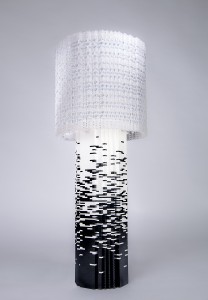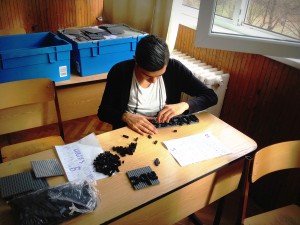The original version of this article contained an error and has been changed. See the bottom of the article for additional information.
Seventeen years ago, under the lights of his Christmas tree, six-year-old David Tracy unwrapped his present and began building his future, brick by brick.
“I got a set of Legos that was just a box of bricks,” Tracy said. “I built a windmill, and then I took that apart. Then I started building a model house, and I got this feeling I can’t really explain.”
Several Christmas sets and thousands of bricks later, Tracy, a UCLA alumnus who studied business economics and architectural studies, is now a professional Lego artist. His work will be featured at the Forest Lawn Museum in Glendale until May 26 in an exhibition titled “A Million and One Pieces,” and his ideas will be crossing international waters as part of a citywide Lego building project in the city of Nyíregyháza, Hungary.
An investment banker by day and a master builder by night, Tracy specializes in creating furniture art and fully functioning lamps out of Lego bricks.
Before laying his hands on any pieces, Tracy said he starts his process with a plan in mind, a mental picture of what he wants his sculpture to be.
As a child, these plans were usually for model houses and skyscrapers, often mimicking architecture he would see.
“I guess I could imagine myself as a little Lego person inside this house – what it felt like to have a living space in one area, and a loft in another,” he said.
In his first year of college, however, Tracy shifted his focus to a different type of art that was, even for Lego art, less conventional.
“I found a couple of articles in Architectural Digest with Lego furniture,” he said. “I looked at it and said to myself, ‘I could do much better than that.'”
During his next visit home, he gathered up all his bricks and continued to pick up more and more pieces from a local store until, as a first-year student in his Sproul Hall dorm room, Tracy built his first lamp.
“I remember when I was building it, I just couldn’t stop,” Tracy said. “My friends invited me out to go to dinner, and I took the pieces with me. I didn’t really eat much, but I was the whack job at the end of the table, building my Legos.”

One such piece, on display at the gallery, is “Rainstick Lamp.” Composed of over 8,000 bricks, the sculpture stands about two feet tall with a black-and-white transitioning base pattern, mimicking rainfall. It also showcases a striking feature of Tracy’s work – while a close-up look reveals its blocky texture, a distant glance creates the illusion of complete curvature.
Aside from lamps, Tracy said he often gets other requests and commissions, such as a Lego basketball for a couple celebrating their wedding anniversary, and an urn for a family that had lost their 14-year-old son.
One such request came in the form of a Skype call from a man named Zsolt Hudak, the head of the foreign language department of Wesselényi Miklós Középiskola, Szakiskola és Kollégium, a vocational school in eastern Hungary.
Hudak and his team had spearheaded a project to have students research, photograph and create informational pamphlets on 12 remote villages comprising the county, about which little information is present in English or German.
Still, Hudak said he was looking for something a little bit more, something to bring the project to life.
Hudak’s school has a partnership with one of the few Lego factories in the world, located only a few miles away. Hudak planned to harness access to a wealth of Lego bricks and gather the students and the city to create something special with the bricks – he just didn’t know exactly what. That’s where Tracy fit in.
“When I contacted him, he asked me what we had in mind. I said, ‘Actually, there’s nothing in mind,’” Hudak said. “So we sat down, I sent him all the documents we had created by the students, and we started planning.”
Their goal was to create a set of instructions both feasible and doable within a certain time frame, yet grand enough to attract attention. After months of Skype sessions with Hudak, Tracy conceptualized a two-dimensional map of more than 30,000 pieces.

Once the foundation was set, the pair started planning a 24-hour Lego “build-a-thon,” taking place on March 20, to create the gargantuan map.
The event began to pick up steam in the city, as the local soccer team, basketball team and city theater pledged to provide entertainment and food and lend their hands in the building of the sculpture.
Not all of Tracy’s instructions go as far as Hungary, however.
South of Wilshire, in the Westwood apartment of his girlfriend, UCLA alumna Hannah Warren, Tracy and his college friends host what they call “Lego Sundays.”
The idea is simple: The group gathers at the apartment and Tracy gives the instructions for a sculpture he has in mind. Each person is assigned a portion, and once all the subsections are built, the group puts them together to see the fruits of their labor.
Some of Tracy’s professional work, including the “A Splash of Color” set, a series of multicolored lamps on display at the gallery, are products of several “Lego Sundays.”
Going against the grain of recent cinematic suggestions, Tracy wraps up his work by gluing the bricks together.
“It’s an important part of the process. It helps hold the piece together,” Tracy said. “I think the biggest misconception about creating art with Legos is that it’s not as serious a process: It’s like playing with toys, it’s going to be childish. But I think if you do anything in an involved-enough way, you’ll find a way to make it truly amazing.”
Correction: Tracy’s work will be featured at the Forest Lawn Museum in Glendale.
